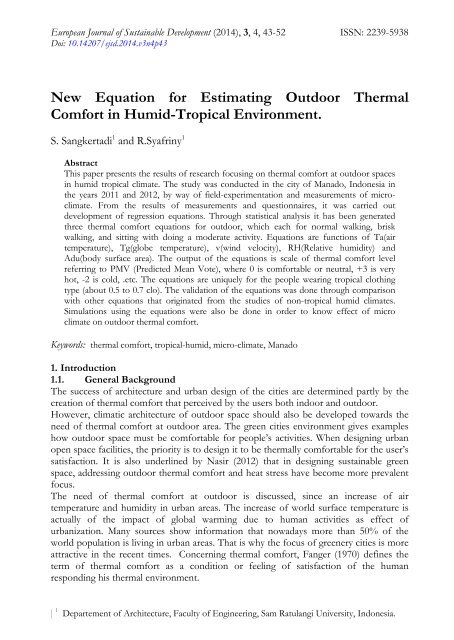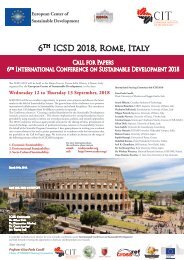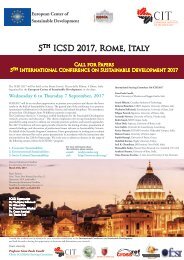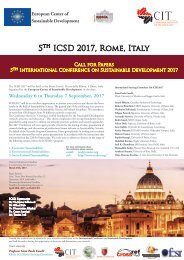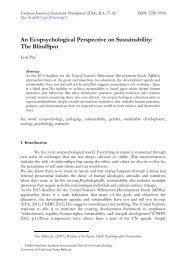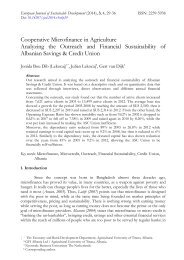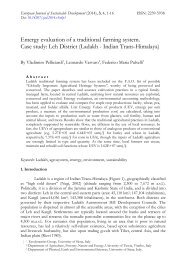European Journal of Sustainable Development (EJSD)
Rome Italy
Rome Italy
Create successful ePaper yourself
Turn your PDF publications into a flip-book with our unique Google optimized e-Paper software.
<strong>European</strong> <strong>Journal</strong> <strong>of</strong> <strong>Sustainable</strong> <strong>Development</strong> (2014), 3, 4, 43-52 ISSN: 2239-5938<br />
Doi: 10.14207/ejsd.2014.v3n4p43<br />
New Equation for Estimating Outdoor Thermal<br />
Comfort in Humid-Tropical Environment.<br />
S. Sangkertadi 1 and R.Syafriny 1<br />
Abstract<br />
This paper presents the results <strong>of</strong> research focusing on thermal comfort at outdoor spaces<br />
in humid tropical climate. The study was conducted in the city <strong>of</strong> Manado, Indonesia in<br />
the years 2011 and 2012, by way <strong>of</strong> field-experimentation and measurements <strong>of</strong> microclimate.<br />
From the results <strong>of</strong> measurements and questionnaires, it was carried out<br />
development <strong>of</strong> regression equations. Through statistical analysis it has been generated<br />
three thermal comfort equations for outdoor, which each for normal walking, brisk<br />
walking, and sitting with doing a moderate activity. Equations are functions <strong>of</strong> Ta(air<br />
temperature), Tg(globe temperature), v(wind velocity), RH(Relative humidity) and<br />
Adu(body surface area). The output <strong>of</strong> the equations is scale <strong>of</strong> thermal comfort level<br />
referring to PMV (Predicted Mean Vote), where 0 is comfortable or neutral, +3 is very<br />
hot, -2 is cold, .etc. The equations are uniquely for the people wearing tropical clothing<br />
type (about 0.5 to 0.7 clo). The validation <strong>of</strong> the equations was done through comparison<br />
with other equations that originated from the studies <strong>of</strong> non-tropical humid climates.<br />
Simulations using the equations were also be done in order to know effect <strong>of</strong> micro<br />
climate on outdoor thermal comfort.<br />
Keywords: thermal comfort, tropical-humid, micro-climate, Manado<br />
1. Introduction<br />
1.1. General Background<br />
The success <strong>of</strong> architecture and urban design <strong>of</strong> the cities are determined partly by the<br />
creation <strong>of</strong> thermal comfort that perceived by the users both indoor and outdoor.<br />
However, climatic architecture <strong>of</strong> outdoor space should also be developed towards the<br />
need <strong>of</strong> thermal comfort at outdoor area. The green cities environment gives examples<br />
how outdoor space must be comfortable for people’s activities. When designing urban<br />
open space facilities, the priority is to design it to be thermally comfortable for the user’s<br />
satisfaction. It is also underlined by Nasir (2012) that in designing sustainable green<br />
space, addressing outdoor thermal comfort and heat stress have become more prevalent<br />
focus.<br />
The need <strong>of</strong> thermal comfort at outdoor is discussed, since an increase <strong>of</strong> air<br />
temperature and humidity in urban areas. The increase <strong>of</strong> world surface temperature is<br />
actually <strong>of</strong> the impact <strong>of</strong> global warming due to human activities as effect <strong>of</strong><br />
urbanization. Many sources show information that nowadays more than 50% <strong>of</strong> the<br />
world population is living in urban areas. That is why the focus <strong>of</strong> greenery cities is more<br />
attractive in the recent times. Concerning thermal comfort, Fanger (1970) defines the<br />
term <strong>of</strong> thermal comfort as a condition or feeling <strong>of</strong> satisfaction <strong>of</strong> the human<br />
responding his thermal environment.<br />
| 1 Departement <strong>of</strong> Architecture, Faculty <strong>of</strong> Engineering, Sam Ratulangi University, Indonesia.
44<br />
<strong>European</strong> <strong>Journal</strong> <strong>of</strong> <strong>Sustainable</strong> <strong>Development</strong> (2014), 3, 4, 43-52<br />
Recently, the principal objective <strong>of</strong> thermal comfort criteria is mostly for standardization<br />
<strong>of</strong> buildings types and its equipments in order to achieve energy efficiency and indoor<br />
environmental friendly. However, from the view<br />
point <strong>of</strong> thermal perception, the<br />
problem occurred at outdoor space<br />
may be different from the indoor situation and may<br />
lead to the different<br />
concept <strong>of</strong> thermal comfort for outdoor spaces. The mean radiant<br />
temperature <strong>of</strong> inner surfaces in such indoor spaces is same or almost same as its indoor<br />
air temperature due<br />
to the closed characteristic <strong>of</strong><br />
rooms and that well protected<br />
from<br />
outdoor thermal environment. But at outdoor, especially in tropical regions, average <strong>of</strong><br />
radiant temperatures is significantly more influenced by direct solar radiation and<br />
surfaces temperature (material <strong>of</strong> streets, pedestrians, buildings<br />
envelop, and other<br />
surfaces <strong>of</strong> urban furniture), and may reach a value that much higher than the outdoor<br />
air temperature. This paragraph may leads us to put hypothesis that the mean radiant<br />
temperature contribute as the most sensitive micro climate component on outdoor<br />
comfort <strong>of</strong> human activities in humid tropical region.<br />
1.2. The City <strong>of</strong> Manado and its climate<br />
Manado is one <strong>of</strong> the cities that geographically positioned at warm and humid climate<br />
region, in Indonesia. The climate is characterized by<br />
relatively high air temperature,<br />
much<br />
sun-lighhabitat <strong>of</strong> about 410 thousands people in 2012.The population density is about 2650<br />
and high humidity. Manado is the coastal city located in 1,5 N and 125 E, with<br />
people/km 2 . The average diurnal air temperature is<br />
varied between<br />
about 20 0 C to<br />
32 0 C.<br />
Relative air humidity, in average is about 70% to 90%. Daily solar radiation may<br />
reach<br />
more<br />
than 4000 Wh/m 2 (Fig.2 & 3). Manado is a waterfront city<br />
that consisted 20 km<br />
long<br />
<strong>of</strong> coastal lines, having sloping<br />
landscape natural scenery and<br />
plenty <strong>of</strong> smalll rivers<br />
flow<br />
into the sea. Manado as the capital <strong>of</strong> province <strong>of</strong> Sulawesi Utara (North Sulawesi,<br />
Indonesia), has great opportunity to develop outdoor space as public places at<br />
some<br />
strategic areas for providing the need <strong>of</strong> outdoor activities. As an enjoyable place<br />
in the<br />
city, open space design should begin with an understanding <strong>of</strong> the future use <strong>of</strong> the<br />
property, and the proper design willl be unique to a specific site and<br />
should be based on a<br />
careful review process. In case <strong>of</strong> Manado, urban changed occurred significantly in very<br />
short term.<br />
Figure.1. Aerial view <strong>of</strong> Manado City (source: YP Photography and authors)<br />
1.3. Related studies<br />
There are fundamental differences concerning the method <strong>of</strong> calculation <strong>of</strong> the thermal<br />
comfort for indoor and outdoor, especially in tropical humid environment. At outdoor<br />
penetration <strong>of</strong> direct solar radiation<br />
and its radiant temperature can affect significantly<br />
Published by ECSDEV, Via dei Fiori, 34, 00172, Rome, Italy<br />
http://ecsdev.org
S. Sangkertadi and R. Syafriny<br />
45<br />
34<br />
32<br />
MAX<br />
AVG<br />
MIN<br />
34<br />
32<br />
MAX AVG MIN<br />
Deg. Celcius<br />
30<br />
28<br />
26<br />
24<br />
Deg. Celcius<br />
30<br />
28<br />
26<br />
24<br />
22<br />
20<br />
18<br />
Air Temperature<br />
January 2011<br />
22<br />
20<br />
18<br />
Air Temperature<br />
July<br />
2011<br />
Local Time<br />
Local Time<br />
Figure.2. Air temperature pr<strong>of</strong>ile (source: Meteorology Station <strong>of</strong><br />
Manado 2011)<br />
Wh/m2<br />
2<br />
7000<br />
6000<br />
5000<br />
4000<br />
3000<br />
2000<br />
1000<br />
0<br />
Solar Radiation<br />
%<br />
100<br />
80<br />
60<br />
40<br />
20<br />
0<br />
Relative Humidity<br />
Jan<br />
Feb<br />
Mar<br />
Avr<br />
May<br />
Jun<br />
Jul<br />
Aug<br />
Sep<br />
Oct<br />
Nov<br />
Dec<br />
Month<br />
the<br />
level <strong>of</strong> human thermal comfort. Contrary in the closed room, the radiant<br />
temperature (as average <strong>of</strong> radiant<br />
temperatures <strong>of</strong> internal surfaces: wall-ceiling-floor) is<br />
similar or has little difference than indoor air temperature.<br />
Figure.3. Monthly average solar Radiation and humidity (source: Meteorology Station <strong>of</strong> Manado 2011)<br />
Figure.4. Some open spaces in Manado<br />
That’s why in closed space the radiant temperature may not strong enough as<br />
determinant variable to influence the perception <strong>of</strong> thermal comfort. At the outdoor the<br />
radiant temperature from solar radiation (direct or indirect) may sting the body skin and<br />
cause a feel <strong>of</strong> uncomfortable thermally. In addition, at outside air velocity is generally<br />
greater than in closed room, fortunately the air mass may support the process <strong>of</strong><br />
achievement <strong>of</strong> thermal comfort by convection and sweat evaporation. In this context,<br />
Arens E and Ballanti D (1997) through a field study, has found significant effect <strong>of</strong> wind<br />
speed on human comfort for walking people in open space.<br />
© 2014 The Authors. <strong>Journal</strong> Compilation © 2014 <strong>European</strong> Center <strong>of</strong> <strong>Sustainable</strong> <strong>Development</strong>.
46 <strong>European</strong> <strong>Journal</strong> <strong>of</strong> <strong>Sustainable</strong> <strong>Development</strong> (2014), 3, 4, 43-52<br />
The studies <strong>of</strong> Nikolopoulou & Steemers (2003), Nikolopoulou, Lykoudis and Kikira<br />
(2008) and Ahmed KS (2003) concerning the investigation <strong>of</strong> human thermal comfort in<br />
outdoor space, indicate that when the same climatic condition is applied, the response <strong>of</strong><br />
discomfort at outdoor space is generally smaller compared to the situation when people<br />
are in closed room. There is then, a tendency for people, will be more tolerant in<br />
response to climatic conditions at outside than in a closed space.<br />
Researches on modeling the thermal comfort calculations for outdoor space, especially in<br />
the case <strong>of</strong> humid tropical climate are still relatively rare, mostly more interested for the<br />
cases <strong>of</strong> indoor space. If there are the models are based on empirical studies <strong>of</strong> outdoor<br />
space in cold, temperate and sub tropical climate areas, which are generally based on field<br />
studies in cities in America, Europe, Japan, Hongkong-China, and Australia. Those such<br />
researches carried out by Huang J (Huang et al, 2007), Matzarakis, Mayer & Rutz (2003),<br />
Nikolopoulou M, Lykoudis and Kikira M (2008), Lin TP, Matzarakis and Huang (2010),<br />
Scudo G and Dessi V (2006), J R Spagnolo and de Dear (2003) etc. Thermal comfort<br />
calculation model that be generated through a number <strong>of</strong> studies by those researchers<br />
may be not necessarily appropriate to be applied in cases <strong>of</strong> humid tropical climate,<br />
because <strong>of</strong> possible differences in the perception <strong>of</strong> comfort by people in different<br />
geographical habitation.<br />
Some <strong>of</strong> the authors who conducted researches on outdoor thermal comfort, proposed<br />
regression equations as contribution in modeling calculation for practice quantification<br />
<strong>of</strong> outdoor thermal comfort perception. The regression equations are mostly functions<br />
<strong>of</strong> climate variables such are solar radiation, air temperature, air humidity, wind speed,<br />
and radiant temperature, as shown in Table 1.<br />
Some others researchers have also proposed the temperature index to measure the<br />
level <strong>of</strong> comfort for people at a particular climatic environment, as the Out_SET<br />
(Outdoor Standard Effective Temperature), and TEP (Temperature Effective<br />
Psychologically) by Monteiro and Alucci (2009).<br />
Table.1.<br />
Regression Equations for outdoor thermal comfort<br />
Author(s), Year Equation Climate<br />
Monteiro L M and Alucci M Tsp= -3.557 +0.0632Ta +0.0677Tmr Sub Tropical<br />
P, 2009<br />
+0.0105RH -0.304v<br />
Nikolopoulou M, Lykoudis ASV=0.061Ta +0.091Tg -0.324v +0.03RH -<br />
Moderate<br />
S, Kikira M, 2003<br />
1.455<br />
Cheng V, Ng Edward, 2008 Ts (CHENG) =0.1895Ta -0.7754v +0.0028.S Sub Tropical<br />
Nicol F, Wilson E,<br />
Ueberjahn-Tritta A,<br />
Nanayakkara L and Kessler<br />
M, 2006<br />
Monteiro L M and Alucci M<br />
P, 2009<br />
Givoni & Noguchi (Source:<br />
Gaitani and Santamouris, 2005)<br />
+0.1953hr -8.23<br />
C=1.761 +0.132Ta +0.00108S -0.432 v 0.5<br />
TEP= -3.777 + 0.4828 Ta + 0.5172 Trm +<br />
0.0802 RH – 2.322 va<br />
Ts (GIVONI) =1.7 +0.1118Ta +0.0019S -0.322v -<br />
0.0073RH +0.0054Ts<br />
Cold<br />
Sub Tropical<br />
Cold<br />
Published by ECSDEV, Via dei Fiori, 34, 00172, Rome, Italy<br />
http://ecsdev.org
S. Sangkertadi and R. Syafriny 47<br />
A very good study by Mayer and Hoppe also proposed another temperature index that is<br />
known as PET (Physiologically Effective Temperature), a physiologically indices that<br />
were derived from the human energy balance for the assessment <strong>of</strong> the thermal complex.<br />
The PET which is limited for case <strong>of</strong> people wearing 0.9 clo with 200 W (activity) is now<br />
integrated into the RayMan Model (Matzarakis A, Rutz F, and Mayer H, 2007).<br />
2. Methods<br />
The methods <strong>of</strong> the study consist <strong>of</strong> outdoor experiment, measurements and<br />
regression analysis. By applying outdoor experimentation, 300 samples <strong>of</strong> adults<br />
participated as respondents/subjects (aged between 17 to 50 years) consisted <strong>of</strong> 180 men<br />
and 120 women. They were asked to wear a type <strong>of</strong> lightweight tropical clothing (0.5 -<br />
0.7 clo). Their weight and height were also measured in order to obtain inputs for<br />
calculating body surface area. The subjects were divided into 2 groups following to two<br />
types <strong>of</strong> location, that is at a place under shaded <strong>of</strong> trees (protected from direct sunlight),<br />
and at other place where it was fully exposed to direct sunlight (open-sky or sunny).<br />
These groups were then divided again into 3 sub groups <strong>of</strong> activities: normal walking<br />
(1.8-2.2 km/h; met=110 W/m 2 ), brisk walking (4-5 km/h; met=200 W/m 2 ) and sitting<br />
with medium activity (reading, speaking, doing computer). A treadmill was used as<br />
equipment for the samples/ subjects for walking facility with a constant speed. At same<br />
time a breeze <strong>of</strong> wind was directed to the body by applying a standing fan with a certain<br />
air velocity.<br />
Each subject has walked on treadmill for 2 minutes 5 times, with a pause <strong>of</strong> about 2<br />
minutes each. After walking <strong>of</strong> each 2 minutes, at a pause time, they filled simple<br />
questionnaire concerning their thermal comfort perception. At the same time,<br />
measurement <strong>of</strong> surface body skin temperature, air temperature, humidity, land surface<br />
temperature, air velocity and globe temperature were done. Measurement equipments<br />
used were: thermo-hygrometer, anemometer, infrared thermometer, solar-power meter,<br />
and globe thermometer. Period and time <strong>of</strong> outdoor experimentation was from May to<br />
July 2011 and July to September 2012 at day time (08.00 am to 05.00 pm).<br />
The data obtained from measurement and questionnaires were then compiled and<br />
analyzed with focusing on the correlation among three factors: the value represent <strong>of</strong><br />
thermal comfort perception, climate characteristics, and parameters <strong>of</strong> the human body.<br />
Then proceed with statistical analysis to obtain the regression equation Y = f (x, y), where<br />
‘Y’ is a number that indicates sense <strong>of</strong> thermal comfort, and ‘x’ is the climate variables<br />
(air temperature, globe temperature, relative humidity, air velocity, and solar radiation), ‘y’<br />
is the parameters and variable <strong>of</strong> the body (height, weight, skin temperature and dress).<br />
Table 2 shows the syntax <strong>of</strong> the thermal response that corresponded to integer value <strong>of</strong><br />
‘Y’. More detail explanation method <strong>of</strong> the study has published by same authors<br />
(Sangkertadi and Syafriny, 2012)<br />
3. Result and discussion<br />
3.1. The regression equations<br />
Based on the data from measurements and questionnaires and through a<br />
statistical analysis, three regressions equations have been successfully developed, and that<br />
© 2014 The Authors. <strong>Journal</strong> Compilation © 2014 <strong>European</strong> Center <strong>of</strong> <strong>Sustainable</strong> <strong>Development</strong>.
48 <strong>European</strong> <strong>Journal</strong> <strong>of</strong> <strong>Sustainable</strong> <strong>Development</strong> (2014), 3, 4, 43-52<br />
represent three modes <strong>of</strong> activities: normal walking, brisk walking and seated with a<br />
moderate action.<br />
Table. 2. Description <strong>of</strong> ‘Y’<br />
Value <strong>of</strong><br />
‘Y’<br />
Comfort Level Perception<br />
(refereed to PMV scale)<br />
-2 Cold<br />
-1 Cool<br />
0 Comfort/ Neutral<br />
1 Warm / Slightly hot<br />
2 Hot<br />
3 Very Hot<br />
4<br />
5<br />
Very-very Hot and feel pain<br />
Very not tolerable<br />
For the case <strong>of</strong> normal walking (speed <strong>of</strong> about 2 km/h), the regression equation is as<br />
follows:<br />
Y JS = -3.4 -0.36v +0.04Ta +0.08Tg -0.01RH + 0.96Adu<br />
(Multiple R = 0.70)<br />
For the case <strong>of</strong> brisk walking (speed <strong>of</strong> about 4-5 km/h) the regression equation was obtained:<br />
Y JC = 2.53 -0.29v +0.11Ta +0.05Tg -0.0009RH + 0.35Adu<br />
(Multiple R = 0.5)<br />
The regression equation for the case <strong>of</strong> seated people with moderate activity, is as follow:<br />
Y DS = -7.91 -0.52v +0.05Ta +0.17Tg -0.0007RH + 1.43Adu<br />
(Multiple R = 0.75)<br />
Where :<br />
v : Air velocity (m/s)<br />
Ta : Air temperature ( 0 C)<br />
Tg : Globe Temperature ( 0 C)<br />
RH : Relative Humidity (%)<br />
Adu : Area <strong>of</strong> body skin (surface <strong>of</strong> du Bois, m 2 )<br />
The coefficients and variables <strong>of</strong> the new three equations above are different from<br />
equations by other authors that be shown in the Table.1. In addition, the new equations<br />
take into account <strong>of</strong> the body skin surface (Adu) as variable, which is not considered by<br />
the other comparator equations.<br />
Some calculations by using the new equations have been done in order to know the<br />
sensitivity <strong>of</strong> the equations to micro-climate variables, where the results are shown by the<br />
graphics in the Figure.4a to 4h. The objective is to know the effect <strong>of</strong> air velocity on<br />
outdoor thermal comfort, coupled with variation <strong>of</strong> temperatures. The different values<br />
<strong>of</strong> Ta (air temperature) and Tg (globe temperature) were applied. It is shown, that wind<br />
velocity may influence to increase the sense <strong>of</strong> comfort significantly. It is indicated that<br />
increase <strong>of</strong> air velocity <strong>of</strong> 1 m/s may improve the scale <strong>of</strong> comfort level <strong>of</strong> around 0.5 to<br />
1.5 on average for three types <strong>of</strong> activity. It is also shown that Tg as representation <strong>of</strong><br />
mean radiant temperature play significant role in perception <strong>of</strong> comfort (presented in the<br />
Figures 4h and 4f).<br />
Published by ECSDEV, Via dei Fiori, 34, 00172, Rome, Italy<br />
http://ecsdev.org
S. Sangkertadi and R. Syafriny 49<br />
Comfort Scale (Y)<br />
3.0<br />
2.5<br />
2.0<br />
1.5<br />
1.0<br />
0.5<br />
0.0<br />
-0.5<br />
-1.0<br />
-1.5<br />
Ta=28 0 C; Tg=32 0 C<br />
0.5 1 1.5 2 2.5 3 3.5 4<br />
v (m/s)<br />
Yjs<br />
Yjc<br />
Yds<br />
Comfort Scale (Y)<br />
3.0<br />
2.5<br />
2.0<br />
1.5<br />
1.0<br />
0.5<br />
0.0<br />
-0.5<br />
-1.0<br />
-1.5<br />
-2.0<br />
Ta=28 0 C; Tg=28 0 C<br />
0.5 1 1.5 2 2.5 3 3.5 4<br />
v (m/s)<br />
Yjs<br />
Yjc<br />
Yds<br />
Figure.4a<br />
Figure.4b<br />
Comfort Scale (Y)<br />
3.0<br />
2.5<br />
2.0<br />
1.5<br />
1.0<br />
0.5<br />
0.0<br />
-0.5<br />
-1.0<br />
-1.5<br />
-2.0<br />
Ta=29 0 C; Tg=29 0 C<br />
0.5 1 1.5 2 2.5 3 3.5 4<br />
v (m/s)<br />
Yjs<br />
Yjc<br />
Yds<br />
Comfort Scale (Y)<br />
3.0<br />
2.5<br />
2.0<br />
1.5<br />
1.0<br />
0.5<br />
0.0<br />
-0.5<br />
-1.0<br />
-1.5<br />
Ta=31 0 C; Tg=31 0 C<br />
0.5 1 1.5 2 2.5 3 3.5 4<br />
v (m/s)<br />
Yjs<br />
Yjc<br />
Yds<br />
Figure.4c<br />
Figure.4d<br />
Comfort Scale (Y)<br />
3.0<br />
2.5<br />
2.0<br />
1.5<br />
1.0<br />
0.5<br />
0.0<br />
-0.5<br />
-1.0<br />
-1.5<br />
Ta=32 0 C; Tg=32 0 C<br />
0.5 1 1.5 2 2.5 3 3.5 4<br />
Yjs<br />
Yjc<br />
Yds<br />
Comfort Scale (Y)<br />
3.0<br />
2.5<br />
2.0<br />
1.5<br />
1.0<br />
0.5<br />
0.0<br />
-0.5<br />
-1.0<br />
-1.5<br />
Ta=32 0 C; Tg=40 0 C<br />
0.5 1 1.5 2 2.5 3 3.5 4<br />
Yjs<br />
Yjc<br />
Yds<br />
v (m/s)<br />
v (m/s)<br />
Figure.4e<br />
Figure.4f<br />
Comfort Scale (Y)<br />
3.0<br />
2.5<br />
2.0<br />
1.5<br />
1.0<br />
0.5<br />
0.0<br />
-0.5<br />
-1.0<br />
-1.5<br />
Ta=30 0 C; Tg=30 0 C<br />
0.5 1 1.5 2 2.5 3 3.5 4<br />
Yjs<br />
Yjc<br />
Yds<br />
Comfort Scale (Y)<br />
3.0<br />
2.5<br />
2.0<br />
1.5<br />
1.0<br />
0.5<br />
0.0<br />
-0.5<br />
-1.0<br />
Ta=30 0 C; Tg=35 0 C<br />
0.5 1 1.5 2 2.5 3 3.5 4<br />
Yjs<br />
Yjc<br />
Yds<br />
v (m/s)<br />
v (m/s)<br />
Figure.4g<br />
Figure.4h<br />
© 2014 The Authors. <strong>Journal</strong> Compilation © 2014 <strong>European</strong> Center <strong>of</strong> <strong>Sustainable</strong> <strong>Development</strong>.
50<br />
<strong>European</strong> <strong>Journal</strong> <strong>of</strong> <strong>Sustainable</strong> <strong>Development</strong> (2014), 3, 4, 43-52<br />
The new regression equations that were found through this study<br />
are useful as tool aid<br />
for designing facilities in open-spaces <strong>of</strong> the cities in warm humid environment. For<br />
example, when designing <strong>of</strong> outdoor-cafes, installation <strong>of</strong> standing fan and canopies, may<br />
be required, in order to obtain the temperatures and air velocity<br />
sufficiently for user<br />
comforts (Figure.5). In this case, the optimum wind speed and maximum <strong>of</strong> radiant<br />
temperature can be<br />
determined by using the equation. Then it<br />
can be decided the<br />
position and types <strong>of</strong> fan, types <strong>of</strong> canopy and surface material at open-space. However<br />
to apply the equations, it requires climatic data that can be obtained from the results <strong>of</strong><br />
measurements, such<br />
as from meteorological stations or by direct measurement in situ. In<br />
general, many <strong>of</strong> published-meteorological-data, mentions only the hourly-daily <strong>of</strong> air<br />
temperature, humidity and wind. In<br />
order to complete the lack <strong>of</strong> data on solar radiation,<br />
radiant temperature and globe temperature, it can be obtained through calculations. The<br />
computer program ‘Matahari’ developed by Sangkertadi (2009), can be used to calculate<br />
solar<br />
radiation on various surfaces position. While to calculate Tg, it can be used equation<br />
from<br />
the study <strong>of</strong> Dimiceli, Piltz and Amburn (2011) that based on the values <strong>of</strong> Ta, v<br />
and RH.<br />
Figure.5. Fan and Canopy<br />
at open-spaces in tropical humid area.<br />
3.2. Comparative Study<br />
Comparison<br />
the equations<br />
with other calculation models (Table.1) was also<br />
realized. The objective is as validation <strong>of</strong> the equations by a comparative manner. It was<br />
found that there are<br />
difference values between the results by using the new equations<br />
from<br />
the study and<br />
other models where applying<br />
the same values <strong>of</strong> variables. The<br />
climate variables that applied for comparison are shown in the Table.3 which is typically<br />
represented <strong>of</strong> humid-tropical climate.<br />
The comparison <strong>of</strong> equations whichh is shown in the Figure.6 indicates that the results <strong>of</strong><br />
regression equation Yjs are almost the same as the<br />
results <strong>of</strong> Tsp. It is logical, as<br />
Tsp is<br />
formulation based on sub tropical climate, in which climatologically, it does not have<br />
widely differences compared to tropical humid climatic situation. Figure.6 also shows<br />
that there are significantly different results <strong>of</strong> calculation, between using new equation<br />
Yjs and other models such are C, Ts, and ASV, when a constant air velocity <strong>of</strong> 1 m/s is<br />
applied.<br />
Conclusion<br />
Components <strong>of</strong> thermal comfort equation for outdoor spaces formed not only <strong>of</strong> micro-<br />
climate factors but also the human factors (activity, size and clothing).<br />
Published by ECSDEV, Via dei Fiori, 34, 00172, Rome, Italy<br />
http://ecsdev.org
S. Sangkertadi and R. Syafriny 51<br />
Hour<br />
S RH Ta Ts Tg Trm<br />
(W/m 2 ) (%) ( 0 C) ( 0 C) ( 0 C) ( 0 C)<br />
7 113.42 57 27.5 31.0 37.0 39.2<br />
8 305.21 56 28.0 37.4 44.9 48.9<br />
9 488.59 55 30.2 45.2 52.9 58.3<br />
10 634.90 51 31.0 50.5 58.0 64.4<br />
11 728.43 52 31.5 53.8 61.1 68.2<br />
12 760.50 51 31.2 54.5 61.7 69.0<br />
13 728.43 52 31.9 54.2 61.5 68.6<br />
14 634.90 52 31.0 50.5 58.0 64.4<br />
15 360.96 56 28.4 39.5 45.2 49.2<br />
16 305.21 59 27.1 36.5 44.0 48.0<br />
17 113.42 59 27.3 30.8 36.8 39.0<br />
Table.3.<br />
Climatic variable (July in Manado) as<br />
input <strong>of</strong> calculation for comparison<br />
Comfort Sensation<br />
VVH 4.0<br />
VH 3.0<br />
2.0 H<br />
SH 1.0<br />
0.0 C<br />
-1.0 CL<br />
CLD -2.0<br />
Comparison <strong>of</strong> the regressions<br />
v=1 m/s; July; Tropics Humid<br />
7 8 9 10 11 12 13 14 15 16 17<br />
Yjs<br />
Tsp<br />
ASV<br />
TS Cheng<br />
TS Givoni<br />
C<br />
Figure.6. Comparison<br />
<strong>of</strong> equations;<br />
C=Comfort;<br />
SH=Slightly Hot;<br />
H=Hot; VH= Very<br />
Hot; VVH=Very<br />
Very Hot; CL=Cool;<br />
CLD=Cold<br />
Hour<br />
The sense <strong>of</strong> thermal comfort at outdoor spaces, is a function integrated <strong>of</strong> variables<br />
and parameters <strong>of</strong> air temperature (Ta), radiant temperature (Tg), wind speed (v) and<br />
human properties (activity, type <strong>of</strong> clothing, body size). Through this study it is found<br />
that thermal comfort equation for outdoor space in warm and humid environments is<br />
specific, and different from other equations which are available for other climates.<br />
The study shows, that in humid tropical climate, wind mass that touch the human body,<br />
can affect the sense <strong>of</strong> outdoor comfort significantly. Beside, mean radiant temperature<br />
that represented by global temperature influence the comfort significantly.<br />
Therefore, the practice to operate the standing fan in the outdoor space is reasonable to<br />
get a sense <strong>of</strong> comfort for the user. In addition, efforts to reduce radiant temperature by<br />
applying shading devices, and application <strong>of</strong> s<strong>of</strong>t surface material and non-heat reflector,<br />
are also the way to reach friendly environment <strong>of</strong> the cities in warm humid climate.<br />
© 2014 The Authors. <strong>Journal</strong> Compilation © 2014 <strong>European</strong> Center <strong>of</strong> <strong>Sustainable</strong> <strong>Development</strong>.
52 <strong>European</strong> <strong>Journal</strong> <strong>of</strong> <strong>Sustainable</strong> <strong>Development</strong> (2014), 3, 4, 43-52<br />
References<br />
Ahmed K S, (2003), Comfort in Urban Spaces: defining the boundaries <strong>of</strong> outdoor thermal comfort for the tropical urban<br />
environment, <strong>Journal</strong>: Energy & Building, vol 35 - 2003<br />
Arens E and Ballanti D, (1997), Outdoor Comfort <strong>of</strong> Pedestrians in Cities, Proceedings <strong>of</strong> The Conference on<br />
Physical Environment, Upper Derby, PA, US 1997.<br />
Cheng V, and Ng E, (2008), Wind for Comfort in High Density Cities, Proceedings <strong>of</strong> The Conference on<br />
Passive and Low Energy Architecture, Dublin 22 - 24 October 2008.<br />
Dimiceli V E, Piltz S F, Amburn S A, (2011), Estimation <strong>of</strong> Black Globe Temperature for Calculation <strong>of</strong> the Wet Bulb<br />
Globe Temperature Index. Proceedings <strong>of</strong> the World Congress on Engineering and Computer<br />
Science-2011 Vol II WCECS 2011, October 19-21, 2011, San Francisco, USA<br />
Fanger P O, (1970), Thermal Comfort – Analysis and Applications in Environmental Engineering, McGraw Hill, New<br />
York.<br />
Gaitani, N, Santamouris M, Mihalakakou G, (2005), Thermal comfort conditions in outdoor spaces, Proceedings <strong>of</strong><br />
International Conference “Passive and Low Energy Cooling May 2005, Santorini, Greece.<br />
Givoni B, and Noguchi, M, (2000), Issues in outdoor comfort research. Proceedings <strong>of</strong> The Conference Passive<br />
and Low Energy Architecture, London, 2000.<br />
Huang J, (2007), Prediction <strong>of</strong> air temperature for thermal comfort <strong>of</strong> people in outdoor environments. Int. <strong>Journal</strong> on<br />
Biometeorology Vol.51, 2007<br />
International Standard Organization, (2003), ISO Standard 7730: Moderate thermal environments – Determination <strong>of</strong><br />
the PMV and PPD indices and specification <strong>of</strong> the conditions for thermal comfort, 2003.<br />
Lin, T.-P. , Matzarakis, A., Hwang, R.-L., Huang, Y.-C, (2010), Effect <strong>of</strong> pavements albedo on long-term outdoor<br />
thermal comfort. Proceedings <strong>of</strong> the 7th Conference on Biometeorology, 2010.<br />
Lin, T.-P., Andrade, H., Hwang, R.-L., Oliveira, S., Matzarakis, A.,(2008), The comparison <strong>of</strong> thermal sensation and<br />
acceptable range for outdoor occupants between Mediterranean and subtropical climates. Proceedings 18th<br />
International Congress on Biometeorology, September 2008.<br />
Matzarakis A, Mayer H, Rutz F, (2003), Radiation and Thermal Comfort, Proceeding <strong>of</strong> 6 th Hellenic Conference<br />
in Meteorology, Climatology and Atmospheric Physics, 2003.<br />
Matzarakis A, Rutz F, and Mayer H, (2007), Modelling radiation fluxes in simple and complex environments—<br />
application <strong>of</strong> the RayMan model. Int J Biometeorology, Vol. 51, 2007.<br />
Monteiro L M, Alucci M P, (2009), An Outdoor Thermal Comfort Index for the Subtropics. Proceeding 26 th PLEA,<br />
2009<br />
Nicol F, Wilson E, Ueberjahn-Tritta A, Nanayakkara L and Kessler M, (2006), Comfort in outdoor spaces in<br />
Manchester and Lewes, UK, Proceedings <strong>of</strong> conference: Comfort and Energy Use in Buildings - Getting<br />
them Right, Cumberland Lodge, Windsor, UK, 27-30 th April 2006. London<br />
Nikolopoulou, M and Steemers, K, (2003), Thermal comfort and psychological adaptation as a guide for designing urban<br />
spaces, Energy and Buildings, vol 35. 2003<br />
Nikolopoulou, M, Lykoudis, S and Kikira, M, (2008), Thermal comfort in urban spaces: field studies in Greece,<br />
Proceedings <strong>of</strong> the fifth International Conference on Urban Climate. September, 2008 Lodz,<br />
Poland.<br />
Nasir R A, Ahmad S Sh and Ahmed A Z, (2012), Psychological Adaptation <strong>of</strong> Outdoor Thermal Comfort in Shaded<br />
Green Spaces in Malaysia, Procedia - Social and Behavioral Sciences 68, 2012<br />
Sangkertadi and Syafriny R, (2012), Proposition <strong>of</strong> Regression Equations to Determine Outdoor Thermal Comfort in<br />
Tropical and Humid Environment, IPTEK, The <strong>Journal</strong> for Technology and Science, Vol. 23, Number<br />
2, May 2012.<br />
Sangkertadi, (1994). Contribution al’Etude du ComportementThermoaureulique des Batiments en Climat Tropical Humide.<br />
Prise en Compte de la Ventilation Naturelle dans l’Evaluation du Confort, These de Doctorat<br />
(unpublished), INSA de Lyon.<br />
Sangkertadi. Petunjuk Pemakaian Program ‘Matahari’,(2009), Fakultas Teknik Unsrat, Manado (unpublished).<br />
Scudo G and Dessi V, (2006). Thermal comfort in urban space renewal, Proceeding 23th PLEA, 2006<br />
Spagnolo J and De Dear R, (2003), A field study <strong>of</strong> thermal comfort in outdoor and semi-outdoor<br />
environments in subtropical Sydney, Australia, Building and Environment, Volume 38, Issue 5, May,<br />
2003.<br />
Published by ECSDEV, Via dei Fiori, 34, 00172, Rome, Italy<br />
http://ecsdev.org


